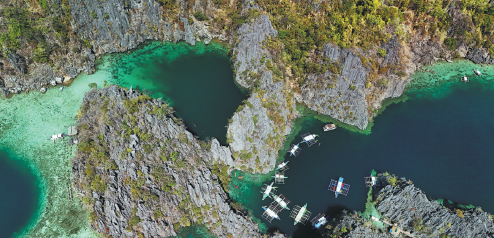Unique opportunities await Philippines explorers

Located in the western Pacific Ocean near the equator, the Philippines is a nation made up of more than 7,000 islands and islets — about 2,000 of which are inhabited.
The archipelago's diverse features draw tourists from all over the world, and in 2023, three of its sites — Boracay, Palawan and Siargao — were voted among the top 10 island destinations in Asia by readers of prestigious luxury and lifestyle magazine Conde Nast Traveler. As well, the Philippines won the best diving destination award at the 2024 DRT (diving, resort and travel) Show Beijing — an addition to the long list of citations recognizing the country's charm as a premier dive spot.
Philippine Department of Tourism (DOT) Secretary Christina Garcia Frasco said: "We welcome the resounding message from tourists from around the world that says beaches, crystal-clear waters, vibrant marine life, lush landscapes, rich heritage and culture, and the excellent hospitality of the Filipino people mean the Philippine experience is always one that is filled with love and happy travels."
Boracay Island
Boracay remains a highlight of Philippine tourism, annually attracting millions of visitors who are drawn to its pristine beaches, turquoise waters, lively community and the promise of unforgettable experiences. It is home to high-end resorts and world-class facilities, offering an unparalleled luxury experience.
In September 2024, the island in Aklan province was voted Asia's Leading Luxury Island Destination at the World Travel Awards Asia and Oceania Gala Ceremony, and it was named the World's Leading Luxury Island Destination 2024 at the World Travel Awards Grand Final Gala Ceremony in November.
Boracay offers a variety of water-based activities such as scuba diving, snorkeling, kiteboarding, parasailing and stand-up paddleboarding. Its marine ecosystems are very diverse, with vibrant coral reefs that support various fish species and other marine life.
The island also has patches of mangrove forests that play a vital role in maintaining the ecological balance and supporting bird and marine life. Native birds such as the collared kingfisher and other coastal wildlife contribute to the island's unique ecological landscape. Guided eco-tours are available to showcase the island's natural beauty and ongoing conservation efforts, and visitors can also participate in educational tours that emphasize the island's environmental rehabilitation, including beach cleanups and sustainability workshops.
Boracay has been featured as one of the top island destinations in the world by prestigious publications like Conde Nast Traveler and Travel + Leisure.
Mantigue Island
Mantigue boasts a well-preserved marine sanctuary with diverse coral species, sea turtles and a wide variety of fish, such as clownfish and groupers. The clarity of the water makes it an excellent location for observing the local marine biodiversity.
The island's forested interior is home to endemic plant species and supports a variety of birds, making it a wonderful spot for nature enthusiasts and bird-watchers. Its coastal areas are lined with native trees and shrubs, adding to its rich ecological makeup.
While not as widely known as Boracay, Mantigue Island has been acknowledged regionally for its sustainable tourism model, focusing on protecting its natural resources while welcoming visitors. It is renowned for involving local communities in conservation and tourism efforts, ensuring that tourism contributes to environmental and socioeconomic sustainability.
Natural parks
The Philippines is home to a high concentration of coral reef life and a variety of marine species in its world-renowned dive sites, such as Tubbataha Reefs Natural Park in Palawan. The park's incredible biodiversity has earned it UNESCO World Heritage Site status.
The park lies in a unique position in the center of the Sulu Sea and includes the Tubbataha and Jessie Beazley reefs. It protects an area of almost 100,000 hectares of high-quality marine habitats containing three atolls and a large area of deep sea, according to UNESCO's website.
Whales, dolphins, sharks, turtles and Napoleon wrasse are among the key species found here. The reef ecosystems support more than 360 species of coral and almost 700 species of fish, while the reserve protects one of the few remaining colonies of breeding seabirds in the region.
Apo Reef Natural Park is one of the largest contiguous coral reef systems on the planet, spanning 34 square kilometers. Known for its rich marine biodiversity, it attracts divers from around the world to witness its vibrant coral gardens, diverse fish species and occasional sightings of manta rays and sharks. The reef exemplifies the Philippines' commitment to marine biodiversity protection, and the park is one of the five new sites the ASEAN Centre for Biodiversity recently announced as additions to its network of top-notch nature reserves and natural parks in the Southeast Asian region.
Boracay, Mantigue Island and the natural parks highlight the Philippines' commitment to combining tourism with the conservation of its rich natural environment, and stand as shining examples of how responsible tourism can celebrate natural beauty while fostering preservation.
The archipelago also offers visitors the opportunity to explore timeless terraces. The Rice Terraces of the Philippine Cordilleras are a national cultural treasure of the Philippines, carved into the mountains of Ifugao more than 2,000 years ago by the indigenous people. The terraces showcase the unique cultural heritage and agricultural techniques of the Ifugao people and offer breathtaking views of lush and terraced hillsides.
Recognized as a UNESCO World Heritage Site, the Rice Terraces of the Philippine Cordilleras attract visitors from around the globe and stand as a symbol of natural beauty and human ingenuity.
songmengxing@chinadaily.com.cn




















